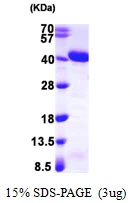
3microg Human APE1 protein (GTX67225-pro) by SDS-PAGE under reducing condition and visualized by coomassie blue stain.
Human APE1 protein, T7 tag
GTX67225-PRO
Product group Molecular Biology
Overview
- SupplierGeneTex
- Product NameHuman APE1 protein, T7 tag
- Delivery Days Customer9
- CertificationResearch Use Only
- Concentration1 mg/ml
- ConjugateUnconjugated
- Scientific DescriptionApurinic/apyrimidinic (AP) sites occur frequently in DNA molecules by spontaneous hydrolysis, by DNA damaging agents or by DNA glycosylases that remove specific abnormal bases. AP sites are pre-mutagenic lesions that can prevent normal DNA replication so the cell contains systems to identify and repair such sites. Class II AP endonucleases cleave the phosphodiester backbone 5 to the AP site. This gene encodes the major AP endonuclease in human cells. Splice variants have been found for this gene; all encode the same protein. [provided by RefSeq, Jul 2008]
- Storage Instruction-20°C or -80°C,2°C to 8°C
- UNSPSC12352204
